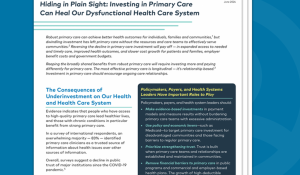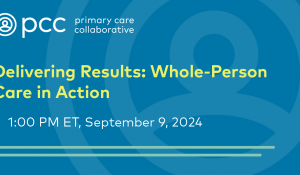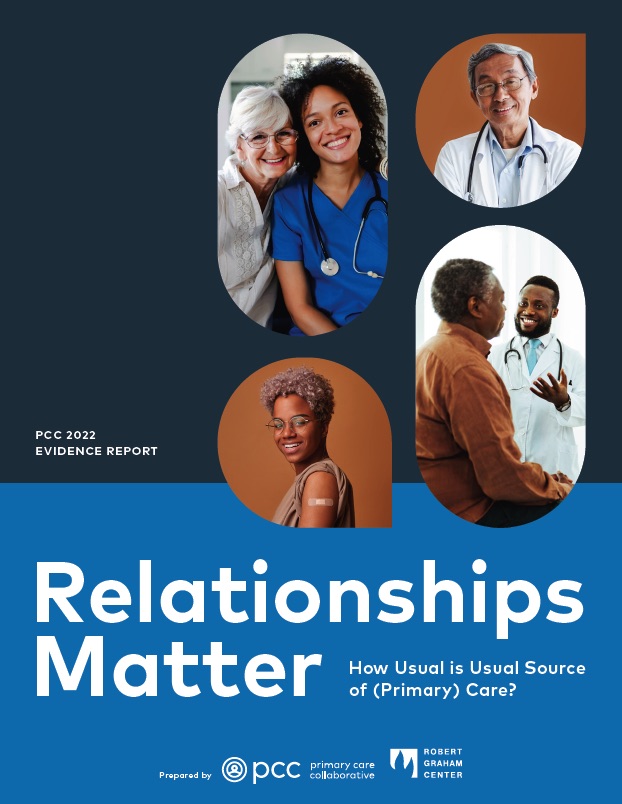As debate over big-ticket infrastructure and budget reconciliation bills unfolds, the Senate Finance and House Energy and Commerce Committees are charting more bipartisan paths on behavioral health, social determinants of health, and vaccine access priorities.
At a June 15 hearing, Senate Finance Committee Chairman Ron Wyden (D-Oregon), Ranking Member Crapo (R-Idaho), and committee members of both parties signaled interest in crafting mental health legislation, potentially incorporating expansions of telemental health and the Certified Community Behavioral Health Clinic (CCBHC) Demonstration. Additional primary care-behavioral health integration policy changes and investments may be on the table in this developing conversation.
In the House, the Energy and Commerce Committee advanced several individual bills on July 21, including measures addressing vaccine policy as well as Medicare and Medicaid initiatives to address social determinants of health.
You are looking at an archived version of our site. Please visit thepcc.org for a fresh, new experience!
Federal Policy Updates
For state specific policy head to State Policy Updates
Bipartisan Momentum Grows for Behavioral Health, Social Determinants, and Vaccine Policy Changes
July 30, 2021
Medicare Part B Proposed Rule Updates Reimbursement, Extends Some Telehealth Authorities
July 30, 2021
On July 13, CMS released its annual Medicare Part B Physician Fee Schedule proposed rule.
Among other provisions, CMS proposes to:
- Update reimbursement for Medicare Part B fee schedule services
- Maintain certain telehealth services on the list of covered Medicare services to Dec. 31, 2023, so that there is a glide path to evaluate whether the services should be permanently added to the telehealth list.
- Reimburse for audio-only telemental health services, provided an in-person service is is provided within six months
- Take steps to expand participation in the Medicare Diabetes Prevention Program Expanded Model by reducing the benefit’s duration from two years to one (aligning the program with Centers for Disease Control and Prevention program design) and reworking the program’s benefit structure
- Refine Medicare’s Quality Payment Program, proposing an increased performance threshold for incentive payment under Merit-based Incentive Payment System and outlining the first seven MIPS Value Pathway (MVP) measure sets.
- Notably, despite the above steps that were proposed by CMS, certain broader waivers of geographic telehealth requirements will expire with termination of the current Public Health Emergency. Additional congressional action will be required.
CMS’ Notice of Proposed Rule Making (NPRM) also requested comment on vaccine administration payment and health equity data collection.
A draft PCC comment letter will be circulated to Executive Members for feedback in advance of CMS’ Sept. 13 deadline.
CMS resources:
PCC Among 430 Organizations Urging Congress to Address ‘Telehealth Cliff’
July 26, 2021
WASHINGTON, July 26, 2021 – The PCC and many of its members are among the 430 organizations that are sending a letter today to Congress to urge policymakers to address the “telehealth cliff.” The letter was co-led by the Alliance for Connected Care, American Telemedicine Association, Consumer Technology Association, eHealth Initiative, HIMSS, Health Innovation Alliance, Partnership to Advance Virtual Care, and PCHAlliance.
If Congress does not act before the end of the COVID-19 public health emergency (PHE), Medicare beneficiaries will lose access to virtual care options which have become a lifeline to many. The letter calls for Congress to advance permanent telehealth reform focused on specific priorities:
- Removing arbitrary restrictions on where a patient must be located in order to utilize telehealth services;
- Ensuring federally qualified health centers, critical access hospitals, and rural health centers can furnish telehealth services;
- Authorizing the Secretary to allow additional telehealth practitioners, services, and modalities; and
- Removing restrictions on telemental health services.
During the pandemic, telehealth has proven to be an efficient and popular tool to deliver high-quality care. Because of this, many clinicians and health systems have made substantial investments in telehealth. Congress must act now to pass legislation to ensure patients and clinicians are not left in the lurch with fewer options to address critical health needs.
Looking Ahead as Public Health Emergency Winds Down
July 1, 2021
As discussion continues about how to extend the enhanced subsidies in the American Rescue Plan, which will expire at the end of 2022, there are calls for improving affordability of both premiums and out-of-pocket costs in marketplace plans. Lowering out-of-pocket costs by making Gold-level plans affordable could improve access to primary care, particularly for lower-income enrollees.
Many temporary COVID-19-related Medicare payment and other waivers are tied to the duration of the national Public Health Emergency (PHE). The American Rescue Plan (ARP) included temporary funding and other temporary policy changes that have significant implications for the primary care community. The table below lists and tracks some important expiration dates.
|
FEDERAL PROGRAM/PROVISION |
EXPIRATION DATE |
|
Public Health Emergency (PHE) declaration from Secretary of Health and Human Services |
Renewed 4/21/21 for 90 days; expected to be renewed through CY 2021 |
|
Provisions of $1.9 trillion American Rescue Plan |
|
|
Medicaid state option for 12 months postpartum |
5 years beginning April 2022 |
|
Enhanced FMAP (85%) for optional state community mobile crisis intervention services |
5 years beginning April 2022 |
|
Two year 5% FMAP incentive (on all Medicaid populations) for states that have not yet expanded Medicaid (on top of 6.2% FMAP if during PHE) |
2 years after state enactment |
|
COVID-19 vaccine coverage for Medicaid/CHIP 100% match; state option for uninsured coverage |
End of first quarter after 12 months after end of PHE |
|
Temporary expansion of ACA marketplace APTCs |
Expire at end of CY 2022 |
|
$8.5 billion for new fund for rural providers to cover losses due to COVID-19 |
Funds available until expended (providers must apply) |
|
$9.1 billion for public health workforce-related grants; $100 million for Medical Reserve Corps; $800 million National Health Service Corps; $200 million Nurse Corps; $330 million for Teaching Health Centers GME (THCGME) programs |
FY 2021; available until expended; All programs extended through FY 2023 |
|
Community Health Center funding of $7.6 billion |
End of FY 2022 |
|
$1.5 billion for Community Mental Health Block Grants; $1.5 billion for Prevention and Treatment of Substance Abuse Grants |
FY 2021; expended by 9/30/25 |
|
Consolidated Appropriations Act, 2021 |
|
|
Medicare 2% sequestration suspended through 3/31/21; Congress extended again in April 2021 |
Expires end of CY 2021 |
|
Medicare PAY-GO cuts of 4% to be triggered by ARP deficit spending unless Congress acts |
Congress must act by 9/30/21 |
|
One-time 3.75% ($3 billion) bump in Medicare physician fees to mitigate offsets in 2021 Physician Fee Schedule |
CY 2021 |
|
Postponed complex E&M codes for Medicare billing |
Until 1/1/2024 |
Federal Policy Developments Related to Primary Care
July 1, 2021
Department of Health and Human Services
The Health Resources and Services Administration (HRSA) announced $125 million in workforce grants to support 14 nonprofit private and public organizations’ efforts toward underserved communities to “engage in locally tailored efforts to build vaccine confidence and bolster COVID-19 vaccinations.” These grants were authorized in the American Rescue Plan.
Centers for Medicare and Medicaid Services
CMS added 2019 Quality Payment Program performance information to the Doctors and Clinicians section of Medicare Care Compare and the Provider Data Catalog. More information.
Center for Medicare and Medicaid Innovation
Elizabeth Fowler, Deputy Administrator and Director of CMMI, has been engaged in a listening tour of stakeholders as part of a review of CMMI models and a new strategic focus. She has mentioned the importance of primary care in several public forums and has included the PCC in her stakeholder outreach. She has also spoken of the importance of incorporating health equity as a formal goal of alternative payment models.
MedPAC
In chapter two of its June report, MedPAC recommends that the Secretary of Health and Human Services “harmonize” and reduce its portfolio of alternative payment models and ensure they work together to support the strategic objectives of reducing spending and improving quality. This recommendation suggests that primary care stakeholders should evaluate the potential of all CMMI and CMS models to drive investment in and transformation of primary care.
Updates on Federal Legislation Related to Primary Care
July 1, 2021
Telehealth
Bills related to telehealth continue to be introduced in both houses of Congress. The Alliance for Connected Care has a comprehensive list of bills and summaries.
Expansion of Teaching Health Centers
Noting that “we need more primary care physicians—that was true before this pandemic and its truer than ever now,” Senate HELP Committee Chair Patty Murray (D-Wash.) joined House Energy and Commerce Chair Frank Pallone (D-N.J.) in introducing new legislation to permanently authorize and expand the Teaching Health Centers Graduate Medical Education program. The bill, the Doctors of Community Act, would expand funding to support 100 new programs and 1,600 new residency slots, which would be filled primarily by residents in primary care.
E&C Hearing: Empowered by Data: Legislation to Advance Equity and Public Health
On June 24, the House Energy & Commerce Committee held a hearing on strategies for digitizing the nation’s public health data systems, insuring interoperability and collection of meaningful, actionable data to support addressing social determinants of health and health equity. Committee members have introduced a series of bills to address these goals. Funding an interoperable public health data system is foundational to successful models of comprehensive primary care.
States Codify Telehealth Payment Parity
July 1, 2021
As states are ending state-level public health emergencies that temporarily added new telehealth payment coverage in Medicaid and other state-funded or -regulated programs and payers, many states are codifying telehealth payment parity for telehealth on a permanent basis. Manatt has a helpful tracker.
Coalescing Around the NASEM Report, Implementing High-Quality Primary Care: Rebuilding the Foundation of Health Care
July 1, 2021
The PCC is working with its members and other leaders in primary care to build unity and momentum for the bold changes the recent NASEM report calls for, particularly those related to payment reform. The report is an opportunity to shift the priorities of our healthcare system and improve the health of communities. The PCC is engaging our community in ongoing conversations to ensure our policy and advocacy agenda leverages this historic opportunity.
Watch the recording of PCC’s May webinar about the report.
Affordable Care Act Celebrates a Good June
July 1, 2021
In early June, the Department of Health and Human Services announced that a record 31 million Americans were enrolled in coverage related to the Affordable Care Act as of February 2021, demonstrating its role as a lifeline for people facing economic and health hardships during the COVID-19 pandemic. Enhanced premium tax credits included in the American Rescue Plan enacted in March 2021 and available during an extended special enrollment period have reduced average monthly premiums by over 40% for returning consumers. Later in June, the U.S. Supreme Court upheld the ACA for the third time and dismissed a challenge brought by Texas and 17 other states on grounds that they were not harmed and therefore lacked standing. The challengers had argued that the entire law was invalid after Congress reduced to zero the ACA’s penalty for failing to enroll in minimum essential coverage in 2017.
New House and Senate bill aims to tackle primary care doctor shortage
June 2, 2021
Congress is considering new legislation aimed at boosting funding for medical education with a goal of tackling a shortage of primary care doctors in underserved areas.
What's New
September 26, 2023
September 11, 2023
September 8, 2023




